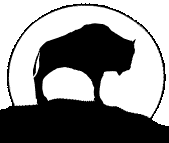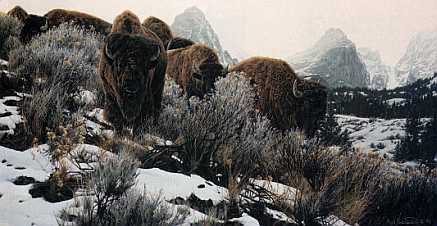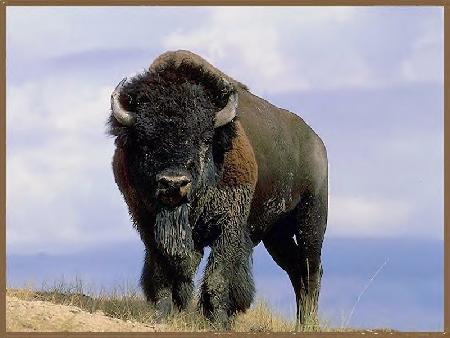|
|
Canku Ota |
|
|
(Many Paths) |
||
|
An Online Newsletter Celebrating Native America |
||
|
December 28December 1, 2001 - Issue 50 |
||
|
|
||
|
How Buffalo Taught The Bully A Lesson |
||
|
paraphrased
by Little Jumper
|
||
|
credits: adapted
from Indian Campfire Tales by W.S. Phillips
|
|
"Ho! Crooked Horns," said Bear. "They say you have been saying you will go to war with me! Put on your war paint now and we will have a big fight!" "I do not want to fight with you, Rootdigger," Buffalo replied. "I want peace, not war." "Ho!" said Bear. "Crooked Horns, you are a coward! You want to run away like an old woman! You are afraid of me!" Then Bear came close and pulled Buffalo's hair and pushed his nose down into the dust. Then he pulled Buffalo's tail and slapped him as hard as he could. "Oh! Rootdigger, you have caused me great pain," said Buffalo as he limped away. "I have done nothing to you and you still have hurt me. That is not right"
As Bear walked away, Buffalo thought to himself, "I really ought to fight him for he is just a mean bully." Bear, by his magic powers, knew what Buffalo was thinking, so he came back and said, "What was that you said about me, Crooked Horns?" Buffalo said, "I said nothing about you." "You speak with two tongues," said Bear. "You were talking in your mind about me and I know it!" Then he mauled Buffalo again, pulling his hair and slapping him. And then he went away laughing. Buffalo thought again to himself, "Now I should surely fight him for he is always picking on someone and wanting to fight." Again Bear knew what Buffalo was thinking and came back and snarled and abused him. Four times this happened. The fifth time, when Bear started to come back to Buffalo, Buffalo backed away and began pawing the earth, still begging Bear not to hurt him. Bear said, "Don't run away Old Woman Crooked Horns. Don't run away. Stand and fight me, Crooked Horns Coward!" But Buffalo kept backing away, and at last, when he was at the edge of a steep bank, he rushed at Bear and knocked him flat. Buffalo stood over Bear and tried to pin him down to the ground with his sharp black horns. "Ho! Do not spear me with your horns! You cause me great pain, Crooked Horns!" cried Bear as he scrambled about, trying to get away from Buffalo. "You wanted to go to war," said Buffalo. "Now why don't you stand up and fight, Old Woman Rootdigger? Why don't you fight me now, I say?" At last Bear scrambled too close to the edge of the high bank, and over he went, right down to the bottom of the river valley. There he lay on his back, where he had fallen, crying and begging Buffalo to let him come up again. Buffalo stood at the top of the bank watching Bear. At last he said, "You are the kind of person who always wants to fight the weak. I should finish this fight and make you pay dearly to teach you a lesson, instead of letting you come back up here to bother decent people." Bear cried, "If you will let me come up, we will make peace and fight no more."
That is how one bully found someone who was not fearful of him and was hurt the way he had been hurting others! A bully has no real courage, and somewhere, sometime, he is going to learn a lesson in life that will hurt him.
|
|
|
|
American Bison (The
Buffalo)
|
|
Since about 1900, the population of bison in North America has increased, but not to anything near its original numbers. The great free-ranging herds have disappeared. The centuries-old migratory trails that the great beasts scored across the western grasslands have given way to freeways and farms. The wild herds that remain move freely only within parks and other wildlife sanctuaries, many of which are fenced. Distribution and
population Two hundred years ago, the plains bison was by far the more common of the two subspecies. It was the dominant grazing animal of the interior plains of the continent, and it often occurred in large herds. A smaller population occurred east of the Mississippi. Today, there are comparatively few plains bison. There are at least 25 herds of plains bison in national and state parks and wildlife refuges in the United States, numbering more than 10,000 animals. There are more than 140,000 in private collections and on a large number of commercial ranches in both Canada and the United States. Description A bison has curved black horns on the sides of its head, a high hump at the shoulders, a short tail with a tassel, and dense shaggy dark brown and black hair around the head and neck. Another distinctive feature of the buffalo is its beard. Most bison live in mixed herds of cows, calves, yearlings, subadults, and a few bulls. The other bulls form groups of their own. The herds are alert and quick to detect changes in their environment. Bison have keen senses of smell and hearing; they can distinguish smells from 3 km away. Buffalo take about eight years
to mature and can live for up to 20 years in the wild. A few have survived
past 30 years in captivity. Movements Life cycle During the mating season, from July to mid-September, the herds move restlessly. "Bull roarings" are heard for kilometres, day and night, as bulls challenge each other in the rutting ritual of the mating season. Most calves are born in May and June, one to each adult female every one or two years. The newborns are tawny yellow with only a faint suggestion of the shoulder hump. Both parents care for their calf to a certain extent, but in the face of danger the calf may be abandoned. The calves, however, rapidly gain in strength and agility, and by autumn they are able to keep up with the herd. Fall is the best season for the buffalo. The flies are gone and the animals fatten rapidly as they prepare for the long cold season ahead. Winter poses few problems for bison, as their winter coats, reinforced by a heavy mane over the vital organs, protect them from the cold, and they can find nourishing grasses and sedges by swinging their head from side to side to push away the snow. The buffalos' instincts protect them in blizzards, as they move into the wind instead of drifting with it like domestic cattle (which are sometimes crushed against fences and killed). The most dangerous season for wild bison is the spring, with the melting of lake and river ice. The buffalo habit of bunching tightly together, safe enough on hard winter ice, often proves fatal in spring conditions, and enormous numbers died when great herds were common. On one day in 1795, a fur trader counted 7360 drowned buffalo in a tributary of the Red River, west of Winnipeg. Habitat and feeding
habits In the days when they grazed on the grasslands in huge numbers, plains bison greatly influenced the ecology of their habitat. Their wallows became temporary ponds in spring and home to a variety of water-loving creatures, such as ducklings and frogs. Their grazing encouraged the growth of grasses that flourish when the vegetation is short. Their heavy grazing coupled with dung production may have been a major factor in building the deep, rich organic soils of the prairies. Predators and
disease Grizzly bears, black bears, grey wolves, and cougars have been known to prey on bison. The grizzly bear was and would still be a deadly enemy, but neither it nor the formidable cougar are numerous in buffalo territory today. Wolves are a danger chiefly to the young, the sick, and the old, because a buffalo in its prime is usually a match for wolves. Bovine tuberculosis and brucellosis are diseases that were brought to North America by European cattle and passed to their relatives, the bison. The herds have also experienced sporadic outbreaks of anthrax, a disease caused by a bacterium that can survive in the soil for decades. Animals that become infected usually die, but anthrax is not carried or harboured by the bison themselves, except during outbreaks of active infection. Relations with
people The arrival of European settlers and professional buffalo hunters destroyed this way of life, driving the bison to near extinction. In those days of unlimited hunting, bison herds were seen to smother in snow in their efforts to escape from humans. Panic-stricken by their enemies, the herds would also stampede over steep banks or into swamps. The destruction of the vast free-ranging bison herds on the prairies, and with it the collapse of the civilization of the Plains Indians, cleared the way for prairie agriculture. Thanks to legal protection from hunting and to ranchers who raised bison as livestock, the plains bison has recovered from near extinction. Increasing numbers inhabit fragments of the species' former territory, many as domesticated livestock, raised for meat on ranches, and others as wildlife, ranging at will within parks and wildlife sanctuaries. At present, because domesticated bison coexist more easily than wild ones with modern prairie life, most bison on the prairies exist on ranches, as livestock. Farmers appreciate the fact that bison are better adapted to prairie droughts and harsh winters than European cattle. Some farmers may also recognize that, because plains bison evolved as part of prairie grassland ecosystems, domesticated bison are potentially more compatible than beef cattle with the region's other native animals and plants. Whether efforts to halt the decline of biodiversity and restore functioning native mixed-grass ecosystems on the prairies will eventually lead to the restoration of herds of wild and semi-wild plains bison to more of their former ranges remains to be seen. © Her Majesty the Queen in Right of Canada, represented by the Minister of Public Works and Government Services Canada, 1999. "Reproduced with permission of the Minister of Public Works and Government Services Canada, 2001 (year)." http://www.cws-scf.ec.gc.ca/hww-fap/bison/bison.html |
|
|
||
| Those who like sat practice questions outlet there is an option for them as different designs. You can shop here not only act prep online but also ccna practice test. Beside you can shop at our fair price shop for asvab practice test. You can get ccna security as well. | ||
|
|
||
|
|
||
| Canku Ota is a free Newsletter celebrating Native America, its traditions and accomplishments . We do not provide subscriber or visitor names to anyone. Some articles presented in Canku Ota may contain copyright material. We have received appropriate permissions for republishing any articles. Material appearing here is distributed without profit or monetary gain to those who have expressed an interest. This is in accordance with Title 17 U.S.C. section 107. | ||
|
Canku Ota is a copyright © 2000, 2001, 2002 of Vicki Lockard and Paul Barry. |
||
 |
 |
|
|
The "Canku Ota - A Newsletter Celebrating Native America" web site and its design is the |
||
|
Copyright © 1999, 2000, 2001, 2002 of Paul C. Barry. |
||
|
All Rights Reserved. |
||
 One
day long ago, Grizzly Bear was traveling through the hills near a
river. He came upon Buffalo Bull standing in the trail. Buffalo's
head was hanging down as if he were weak and sick.
One
day long ago, Grizzly Bear was traveling through the hills near a
river. He came upon Buffalo Bull standing in the trail. Buffalo's
head was hanging down as if he were weak and sick.  "Ho!
You are a coward Crooked Horns! You have the heart of an old woman and
you fear me," said Bear as he turned to continue his travels. "Ho!
I laugh at you! You are a coward!"
"Ho!
You are a coward Crooked Horns! You have the heart of an old woman and
you fear me," said Bear as he turned to continue his travels. "Ho!
I laugh at you! You are a coward!" So.
at last, Buffalo let Bear come back up. Since that time Bear and Buffalo
have been at peace. But Bear still has his bad temper.
So.
at last, Buffalo let Bear come back up. Since that time Bear and Buffalo
have been at peace. But Bear still has his bad temper. Two
hundred years ago, anywhere from 30 to 70 million bison, or buffalo,
roamed free in North America. The aboriginal people who lived on the
Great Plains relied on these wild mammals for food, clothing, and shelter.
During the late 1800s, commercial hide hunters, settlers, and thrill
seekers shot literally millions of bison. This killing spree brought
the species to the verge of extinction and opened up the prairies for
agriculture.
Two
hundred years ago, anywhere from 30 to 70 million bison, or buffalo,
roamed free in North America. The aboriginal people who lived on the
Great Plains relied on these wild mammals for food, clothing, and shelter.
During the late 1800s, commercial hide hunters, settlers, and thrill
seekers shot literally millions of bison. This killing spree brought
the species to the verge of extinction and opened up the prairies for
agriculture. The
bison is the largest land animal in North America. A bull can stand
2 m high and weigh more than a tonne. Female bison are smaller than
males.
The
bison is the largest land animal in North America. A bull can stand
2 m high and weigh more than a tonne. Female bison are smaller than
males. As
summer approaches, buffalo shed their thick winter coats. It is two
months before the new coat appears. During this interval, which is the
peak of the fly season, the buffalo wallow in marshes or dust bowls
to escape from flies.
As
summer approaches, buffalo shed their thick winter coats. It is two
months before the new coat appears. During this interval, which is the
peak of the fly season, the buffalo wallow in marshes or dust bowls
to escape from flies. The
grazing habits of bison are similar to those of domestic cattle. Bison
eat grasses, sedges, forbs, and other ground forage. In the days of
free-roaming herds, the plains bison fed on a variety of native grasses,
which had great nutritional value. In northern areas, the wood bison
fed on a wide variety of grasses and wild forages, but mainly on meadow
sedge, an abundant lowland forage. In winter, they would also eat the
tender twigs of scrubland bushes.
The
grazing habits of bison are similar to those of domestic cattle. Bison
eat grasses, sedges, forbs, and other ground forage. In the days of
free-roaming herds, the plains bison fed on a variety of native grasses,
which had great nutritional value. In northern areas, the wood bison
fed on a wide variety of grasses and wild forages, but mainly on meadow
sedge, an abundant lowland forage. In winter, they would also eat the
tender twigs of scrubland bushes. In the
last century, when buffalo were still plentiful, the Plains Indians
ate buffalo meat and made their clothing and their tepees from buffalo
hides. The native hunters took advantage of the bison's stampeding behaviour.
They drove them over cliffs and into canyons. They often killed 50 or
60 at a time, for it was practically impossible to cut out the needed
few from the tightly massed herd. Nevertheless, buffalo remained plentiful.
In the
last century, when buffalo were still plentiful, the Plains Indians
ate buffalo meat and made their clothing and their tepees from buffalo
hides. The native hunters took advantage of the bison's stampeding behaviour.
They drove them over cliffs and into canyons. They often killed 50 or
60 at a time, for it was practically impossible to cut out the needed
few from the tightly massed herd. Nevertheless, buffalo remained plentiful.